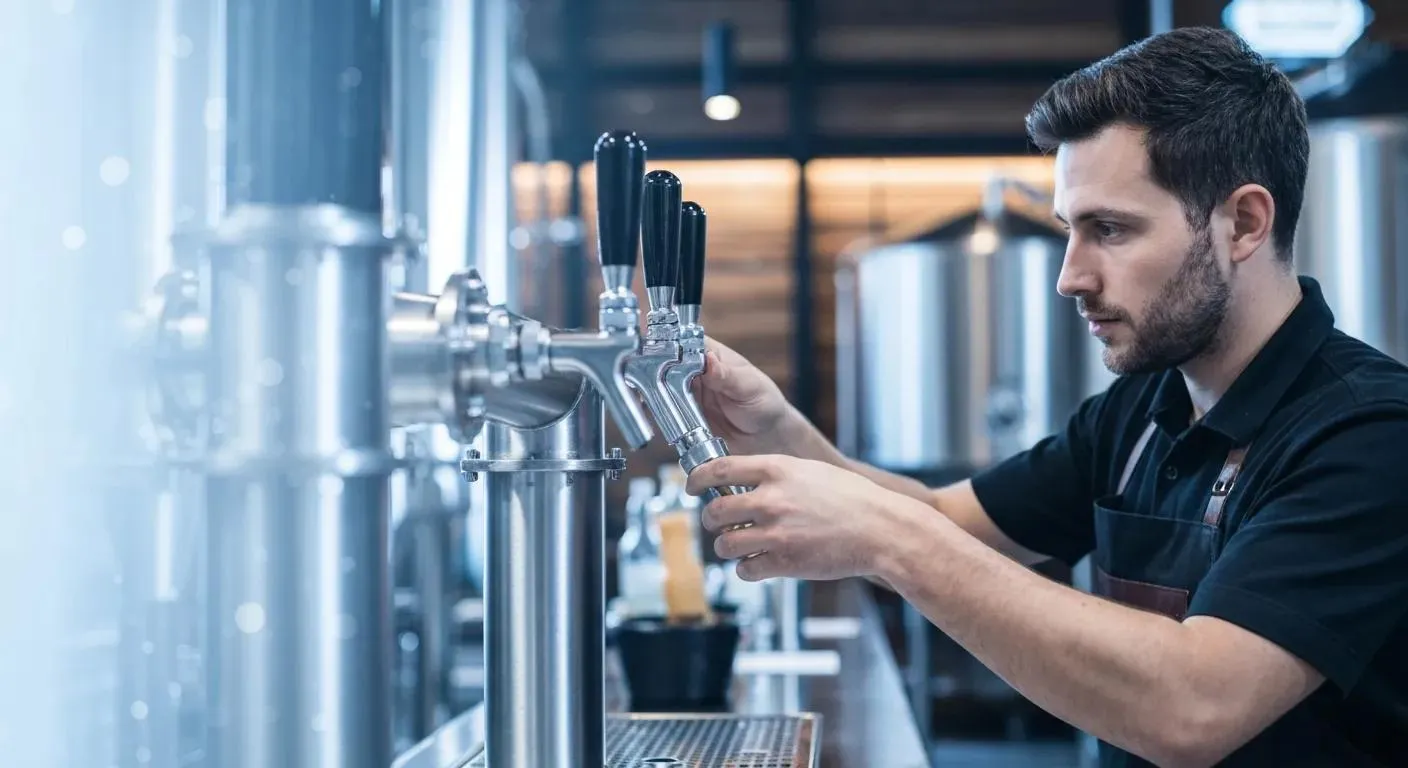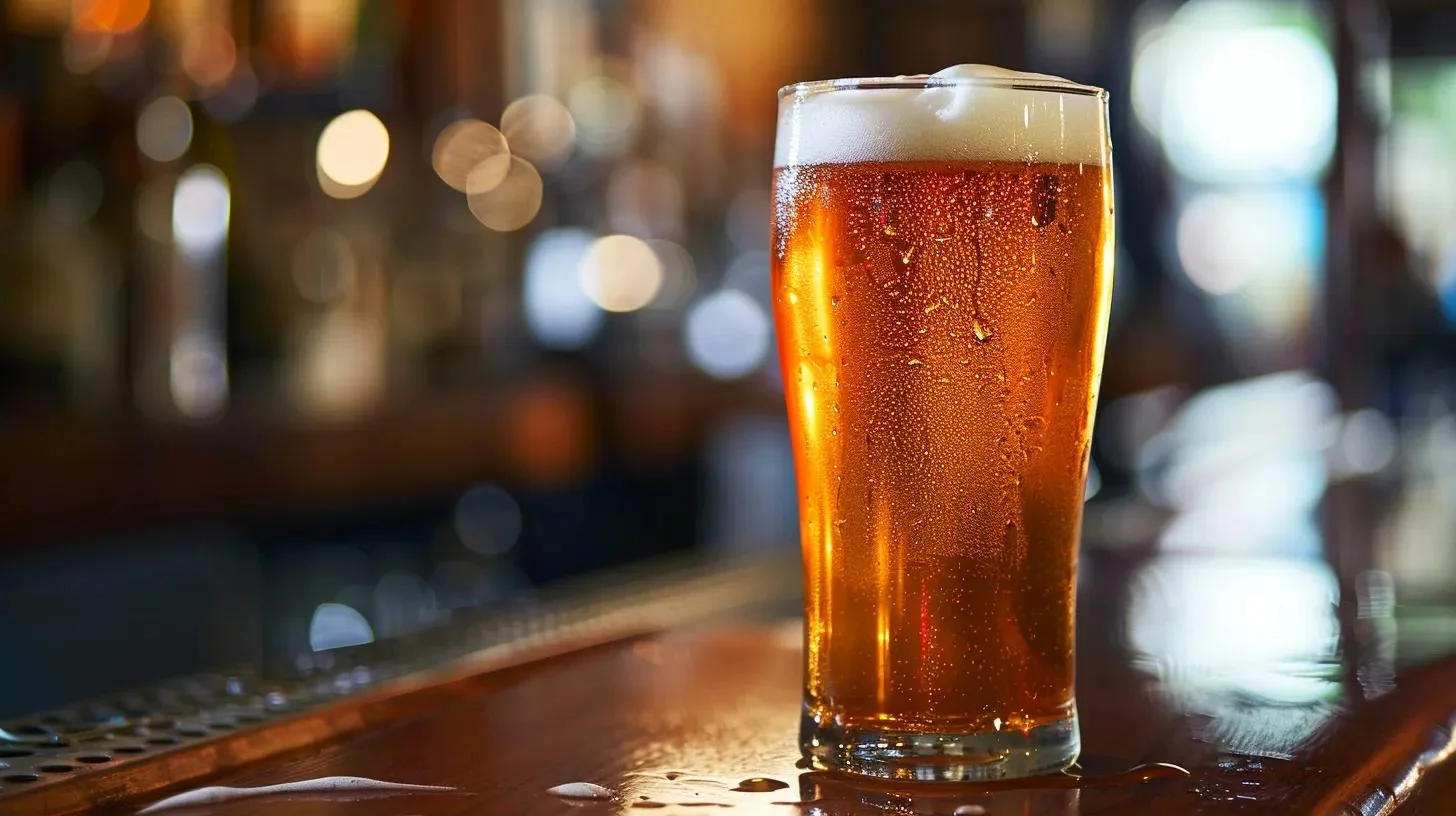Pouring Perfection: The Art and Science of Crafting the Ideal Head Beer Foam

What’s the secret to a perfect ‘head beer’? It’s not just in the pour. The quality of the foam atop your glass affects flavor release and texture, impacting your beer experience. This article delves into the carbonation, ingredients, and techniques that shape that crucial beer foam. Uncover the art and science behind a great beer head without the fluff.
Key Takeaways
- The quality of beer foam is shaped by CO2, proteins like LTP1, and hops that influence the stability and aroma of the foam, and it can be enhanced by the right pouring technique and glassware cleanliness.
- The pouring method impacts foam formation, with techniques like the 45-degree angle pour and adjusting pour speed being crucial for crafting the perfect head.
- Nitrogen can be used instead of carbon dioxide to create a creamier head with a smoother mouthfeel, while factors like brewing ingredients, storage conditions, and serving temperature affect foam quality and stability.
The Essence of Beer Foam

Bubbles. That’s what it all boils down to. The beer foam, also known as beer’s head, is a result of an intriguing process where carbon dioxide bubbles, proteins, and hops work together to form a stable, flavorful foam head. During fermentation, bottling and kegging, yeast and hops act together to create carbon dioxide bubbles, leading to the formation of foam. It’s this foam that greets your lips with the first sip, releasing a burst of aroma and flavor.
But bubbles alone don’t make the cut. Proteins, especially Lipid Transfer Protein (LTP1), and albumins from grains play an instrumental role in stabilizing this foam. They form a protective shroud around the carbon dioxide bubbles, ensuring their persistence. Hops, apart from influencing foam stability, enhance the beer’s overall flavor and aroma. The foam carries odor components through oxidation, significantly impacting the drinker’s sensory experience. Let’s delve deeper into these components.
Carbon Dioxide Bubbles
Carbon dioxide is one of the heroes behind the formation of beer foam. During fermentation, yeast metabolizes sugar-rich molecules to produce ethanol and carbon dioxide, contributing to the beer’s carbonation. The magic happens when the beer is poured and comes into contact with air. The pressurized carbon dioxide gas formed during fermentation is released, creating bubbles that contribute to the beer’s foam head.
It’s a miniature spectacle of chemistry and physics right in your beer glass!
Proteins and Lipid Transfer Protein
Proteins are the unsung heroes in the beer foam saga. Proteins like LTP1, found in the grains used for brewing, are crucial in forming beer foam. LTP1, along with another protein known as protein Z, play a significant role in the formation and stabilization of beer foam by interacting with bitter hop compounds.
Malts rich in proteins and dextrins contribute to the structural components of beer foam, improving body and head retention. So the next time you admire the foam atop your beer, remember the proteins holding it together.
Hops and Iso Alpha Acids
Hops have a twofold role in the beer foam story. They contain hydrophobic proteins that contribute to a more rigid and thick foam. More importantly, hops harbor iso alpha acids, particularly isohumulones, which are key in maintaining foam stability by aiding in bubble cohesion and creating a framework for head formation. Some breweries even use specialized hop extracts like tetra and hexa-iso alpha acids to further enhance foam stability.
The humble hops, it turns out, are integral to our quest for the perfect beer foam, as they contribute to the hop residue that influences the foam’s characteristics.
Mastering the Pour

Now, let’s talk about the art of pouring. The way you pour your beer significantly influences the foam head. It’s not just about tilting the bottle and letting the beer flow into the glass. It’s about mastering the perfect angle and adjusting the pour speed to create an ideal foam head. You’d be amazed at how much a simple adjustment in the pouring technique can enhance your beer-drinking experience.
The perfect pour starts with tilting the glass at exactly 45 degrees. This angle creates a smooth pour and an ideal foam head. You then gradually level the glass during the pour to optimize the foam head, which should be between one-half inch to 1 1/2 inches. But pouring is more than just the angle; it involves understanding the physics of fluid flow and adjusting your pour speed accordingly. Let’s examine the methods more closely.
The 45-Degree Angle
The 45-degree angle pour is a simple yet efficient technique to create the perfect beer foam. By tilting the glass at this angle, you control the flow and reduce splashing, which can lead to excessive foam. The beer gently slides down the side of the glass, reducing agitation and resulting in a smoother pour. This careful maneuver prevents the formation of too much foam, ensuring a proper beer head.
Gradually leveling the glass during the pour allows for the optimal foam head to form. It’s a balancing act that, when mastered, significantly enhances the beer’s visual appeal and sensory experience.
Right-Angled Pour
The right-angled pour is another technique that impacts the formation of beer foam head. By pouring the beer at a right angle, you accelerate the release of carbonation from the beer. This increased release of carbonation results in a thicker foam head.
It’s a technique that requires a bit of practice, but once you get the hang of it, you’ll notice a significant difference in your beer’s foam head.
Adjusting Pour Speed
How fast or slow you pour your beer also plays a role in foam formation. It might seem trivial, but it’s quite significant. A slower pour tends to produce a smaller beer foam head, while a faster pour can create a larger one. By controlling the pour speed, you can lead to variations in foam texture; gentle pour results in finer bubbles and a creamier head.
If you’re serving nitro beers, a ‘hard pour’ is necessary to achieve the desired cascading effect and allow for the proper formation of the stable foam head. Adjusting the pour speed is another tool in your arsenal for crafting the perfect beer foam.
Glassware and Its Impact on Beer Foam

Let’s move on to the unsung hero of the beer foam saga - the beer glass. The type of glassware you use has a significant impact on beer foam, affecting its formation, stability, and overall quality. Factors such as the shape of the glass, its cleanliness, and whether it’s wet or dry play a crucial role in the formation and stability of the beer foam.
Tall, narrow glasses, for example, minimize exposure to ambient air and the ability for CO2 to escape, making them a stellar choice for maintaining beer head formation and retention. But that’s just the tip of the iceberg. Glassware needs to be ‘beer clean’, free of any oil, grease, or residues that could inhibit the formation of bubbles that contribute to beer foam. Whether the glass is wet or dry also matters.
While a wet glass may be beneficial for controlling an overly abundant head in styles like Belgian witbier, it’s generally important to dry glasses thoroughly to prevent water from flattening the beer due to hindered gas excitement. Let’s delve deeper into these factors.
Glass Shape
The shape of the beer glass plays a vital role in initiating the creation of carbon dioxide bubbles and hence the beer foam. Nucleation sites inside beer glasses, like etchings or scratches, play a vital role in initiating the creation of carbon dioxide bubbles and hence the beer foam.
Pilsner and Stange glasses, with their tall, slender shape, are specifically designed to help maintain carbonated beverages’ carbonation, like beer, and sustain its frothy foam head. Weizen glasses feature a design with a narrow base and a wide top, facilitating a gradual rise of carbonation that enhances the head of the beer and captures the sediment typically found in wheat beers.
So, next time you pour your favorite beer, consider the glass shape and how it might enhance your beer experience.
Cleanliness
A clean glass is a happy glass, especially when it comes to beer. A ‘beer clean’ glass devoid of impurities helps maintain CO2 levels, preserving both the visual appeal and taste of beer, and aids in forming an ideal foam head. Impurities in a dirty glass can negatively affect beer’s:
- Appearance
- Flavor
- Foam head
- Carbonation
This can lead to potential losses in profits.
Achieving beer-clean glassware is facilitated through best practices such as hand washing with specific brushes and suds-less detergents, proper sanitization, and allowing glasses to air dry. So, remember to give your beer glass a good clean before enjoying your next pint.
Wet vs. Dry Glasses
The wetness or dryness of your beer glass can also impact your beer foam. Wetting a glass before pouring beer can lead to less foam being produced, as it reduces both friction and the number of nucleation sites for CO2 bubbles. Some bars even use a small waterspout next to the taps to wet the inside of beer mugs before pouring to help control the foam head.
On the other hand, dry glasses with tiny surface defects and residual dust particles provide more nucleation sites for carbon dioxide bubbles, resulting in a more vigorous foam production. A quick rinse with cold water before dispensing beer is recommended to clean away dust particles and slightly cool the glass. It’s a small step that can make a big difference to your beer foam.
Nitrogen Head: A Creamy Alternative

Let’s now delve into the world of nitrogen heads. If you’ve savored a pint of Guinness, you’ve experienced the unique, creamy head that nitrogen brings to the table. Nitrogen is responsible for creating the creamy head found in beers like Guinness, offering a different tactile experience compared to the larger bubbles characteristic of CO2 beers. A firm head with small bubbles characterizes the nitrogen-infused beer head, leading to a smoother texture and reducing foam overrun.
Nitrogen head on beer is created by using a widget in containers or through a nitrogen or mixed gas keg system. Compared to carbon dioxide, nitrogen does not add an acidic bite to beer, enhancing the perception of a smoother, slightly sweeter mouthfeel. Let’s explore this alternative further.
Nitrogen vs. Carbon Dioxide
When it comes to nitrogen versus carbon dioxide in beers, the difference is noticeable. Nitrogen beers usually contain between 70 to 75 percent nitrogen and 25 to 30 percent CO2, contrasting with traditional beers that typically have a majority of CO2.
The smaller bubbles in nitrogen beers contribute to a more stable head or foam, offering a different tactile experience compared to the larger bubbles characteristic of CO2 beers. Unlike CO2, nitrogen does not activate acid taste receptors, leading to a less acidic taste and a smoother sensation, which significantly alters the tasting experience from the sharper taste associated with CO2.
Nitro Beers
Nitro beers have surged in popularity in recent years, with The Left Hand Brewing Company leading the trend as the first to bottle nitro beer without a widget. These beers are known for their distinct cascading effect of bubbles seen during pouring, a key visual aspect that attracts consumers. Nitro beers are diverse, spanning various types like IPAs, stouts, and ales, and are known for their creamier taste and smoother mouthfeel.
The nitrogen also head, known as the beer’s head, has indeed added a delightful twist to the beer world, providing a good head on every pour.
Factors Affecting Beer Foam Quality and Stability

Crafting the perfect beer foam is a complex process, and several factors can affect its quality and stability. From the ingredients used in brewing to the conditions under which the beer is stored, each factor plays a role in shaping the foam head. Even the temperature at which the beer is served can impact the stability and quality of the foam.
Certain malts such as crystal malts, wheat malt, and dark malts are known to enhance foam quality and head retention in beer. Improper storage conditions can negatively impact beer foam stability and quality. The temperature at which beer is served plays a critical role in the stability and quality of its foam.
Let’s delve deeper into these factors.
Storage Conditions
Storage conditions can make or break your beer foam. Extended cold storage of beer doesn’t significantly affect the original wort extract values or the development of bitterness and color, indicating that storage conditions may not alter the fundamental beer properties that affect foam. However, the increase in turbidity seen during beer storage is an indication of decreased colloidal stability, which can lead to less stable foam in head beer.
Larger particle formation is not significant, but the increase in colloidal haze over time affects the beer’s clarity and may impact the perception and quality of the beer foam. So, if you want a perfect beer foam, store your beer right.
Serving Temperature
Last but not least, the temperature at which beer is served can significantly impact the foam’s stability. We recommend serving at 38 degrees fahrenheit for most beers. Serving beer at a chilled temperature improves the foam stability due to increased viscosity. Using a wet glass can help maintain a lower temperature, beneficial for foam control as CO2 is retained better in colder temperatures.
Dry glasses usually result in a more rapid release of CO2 when chilled beer is poured, causing more foam due to the temperature difference. The perfect beer foam is not just about the pour but also about serving it at the right temperature.
Summary
In conclusion, crafting the perfect beer foam is an intricate dance of chemistry, physics, and artistry. From the carbon dioxide bubbles formed during fermentation to the proteins and hops that stabilize the foam, each aspect plays its part. The way the beer is poured, the cleanliness and shape of the glass, and even the temperature at which it’s served, all contribute to the foam’s quality and stability. And let’s not forget the unique, creamy delight of a nitrogen head. So the next time you pour yourself a beer, take a moment to appreciate the foam head. It’s not just a frothy topping; it’s the result of a fascinating interplay of science and art. Here’s to pouring perfection, one beer at a time!
For any other questions about beer foam or draft dispensing reach out to us at Renny's Cheers!



